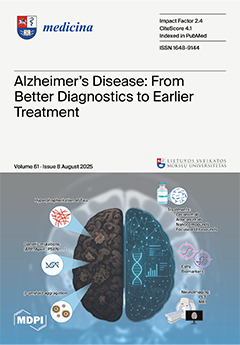Background and Objectives: Carotid artery stenosis is an inflammatory vascular disease closely linked to atherosclerosis and associated with inflammatory biomarkers. The neutrophil/albumin ratio (NAR) is a novel promising biomarker in assessing cardiovascular disease severity. This study aimed to evaluate the relationship between NAR and lesion severity in patients with carotid artery stenosis.
Materials and Methods: This retrospective, single-center, comparative study included 625 asymptomatic patients who underwent digital subtraction angiography (DSA) for suspected high-grade carotid artery stenosis between 2012 and 2022. Patients were classified into two groups based on stenosis severity: critical carotid artery stenosis (≥70% stenosis) and non-critical carotid artery stenosis (<70%). Only asymptomatic patients were included; patients with symptoms were excluded. NAR was calculated preoperatively as neutrophil count divided by serum albumin. Additional inflammatory markers, such as neutrophil–lymphocyte ratio (NLR) and C-reactive protein (CRP) to albumin ratio (CAR), were also analyzed.
Results: Severe carotid artery stenosis was detected in 191 of the patients who underwent DSA. Individuals in the critical carotid artery stenosis group were older and had a higher prevalence of diabetes mellitus and hypertension (51 (45–57) vs. 60 (54–68),
p < 0.001; 143 vs. 83,
p = 0.025; 193 vs. 104, respectively,
p = 0.021), as well as higher neutrophil counts (4.3 (3.2–6.2) vs. 8.1 (4.9–12.5),
p < 0.001), NLR (2.2 (1.4–3.2) vs. 4.2 (2.3–8.9),
p < 0.001), while CRP (3.8 (1.8–8) vs. 5.7 (3.6–7.6),
p = 0.005) and CAR (0.9 (0.5–1.9) vs. 1.6 (0.8–2.1),
p < 0.001) values were significantly higher. NAR was higher in patients of the critical carotid artery stenosis group than the non-critical (1.1 (0.8–1.6) vs. 2.1 (1.4–3.2),
p < 0.001). Multivariate analysis identified NAR as an independent predictor of carotid artery stenosis (Odds Ratio [OR]: 3.432; 95% Confidence Interval [CI]: 2.116–5.566;
p < 0.001). The best cut-off value of NAR for predicting critical carotid artery stenosis was 1.47, which provided 73.8% sensitivity and 70.5% specificity.
Conclusions: NAR, which can be easily measured through a simple blood test, demonstrated moderate sensitivity and specificity in predicting critical carotid artery stenosis, suggesting its potential role as a supportive marker in clinical risk assessment.
Full article






